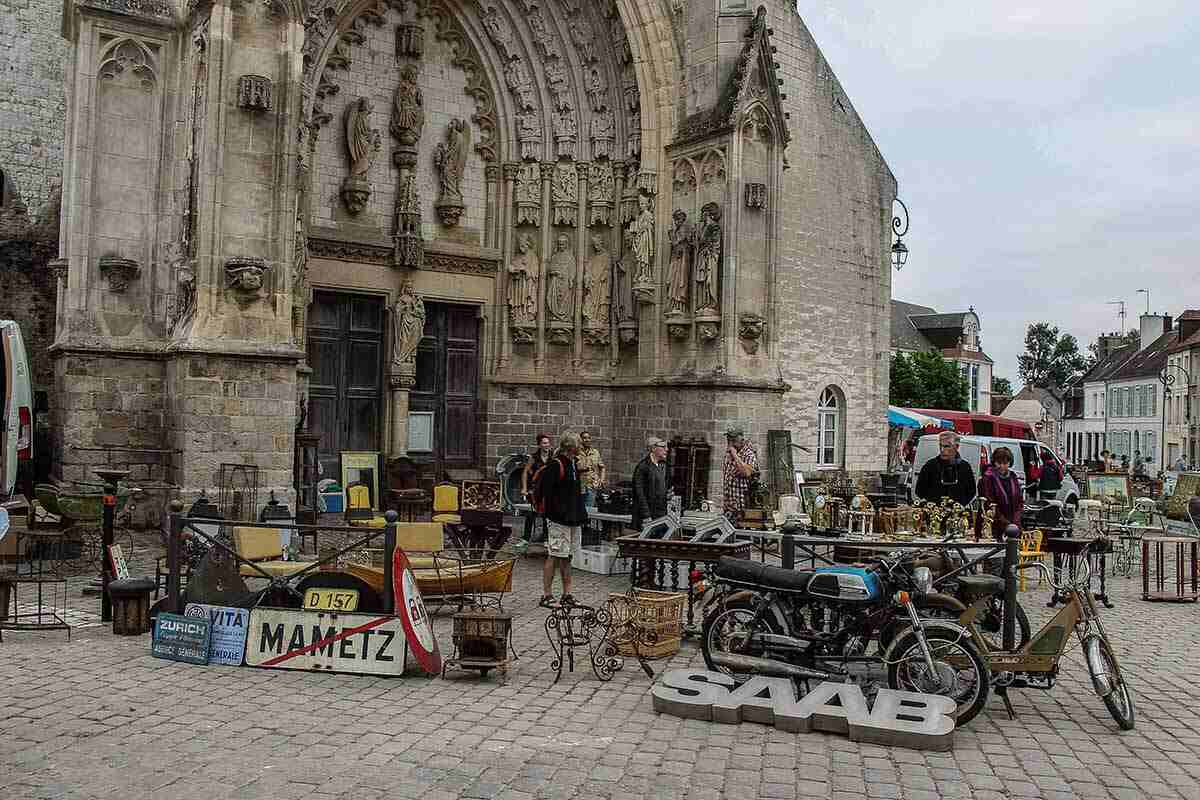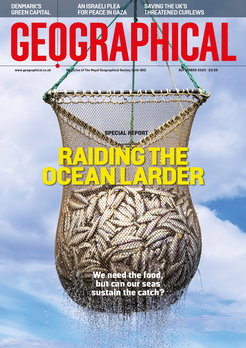
Vitali Vitaliev takes a tour of the small town of Montreuil-sur-Mer in northern France
By Vitali Vitaliev, photographs by Christine Bohling
Nothing about Montreuil-sur-Mer is what you expect.
To begin with, it’s not quite sur mer, but is built on a silted-up river estuary, about 20 miles away from the actual sea. It is also one of the most beautiful and the most ‘French’ towns in France – something that one does not expect to find in the very north of country, with its totally undeserved reputation, both abroad and in the rest of France, of being ‘drab’, ‘poor’ and ‘not French enough’. For many a Brit, ‘real France’ begins much farther to the south – somewhere in Normandy or Brittany, and only a few are aware of the existence of Montreuil-sur-Mer, a little gem of unadulterated ‘Frenchness’ just half a tank of petrol away from London.
‘A quaint, beautiful, characteristic and little-known corner of France, Montreuil preserves better than any place in Great Britain the character of a medieval town,’ wrote Stephen Gwynn, an Irish journalist and MP in his book In Praise of France, 1927.

Montreuil is a stereotype breaker, for almost everything in it defies the concept of a small provincial town. It feels much bigger than it is, and I was genuinely surprised when Pierre Ducrocq, Montreuil’s energetic mayor, told me during my last visit that the town’s present-day population is just over 2,000 – a huge drop from its medieval high of 30,000 people.
I first stepped onto the town’s ancient cobbles 18 years ago and fell in love with the place. Faced with the enforced immobility of lockdowns, I had been missing Montreuil almost like a loved one. There was no question of where to go first after at least some of the travel restrictions got lifted. For me, love is a sensation that encompasses all the senses, and so off I went, with eyes and ears open.
Sight
Names can be misleading. I am told by Pierre Ducrocq, the mayor of Montreuil, that some visitors can still be spotted looking for the sea when in town – and complaining when they fail to find it.
What one cannot overlook, however, are the town’s ubiquitous trees (over a thousand get planted every year) and flowers. In some old streets and winding lanes, Montreuil’s famous Louis-XV, neo-Gothic and Baroque townhouses, including the disproportionally large La Mairie mansion, are hardly visible within the camouflage of the surrounding plane trees and the flowers on their facades. With an overabundance of wisteria-covered balconies and window boxes, bursting with petunias and geraniums, Montreuil is an official ville fleurie, the second most beautiful (according to the latest competition) in the whole of France.

The Montreuillois regard their town’s appearance as an important matter. Every three years a special ‘jury’ checks the existing ‘flower pattern’ and gives advice on how to improve it. The flowers get sprinkled with recycled water only. All public offices are set energy-saving targets and each resident is entitled to a free private garden allotment. Cattle-owners are encouraged to ‘eco-graze’ their sheep, goats and cows on the historic ramparts. The town’s school children spend one day a week on excursions to the neighbouring marshes nature reserve.
The town has been designated a ‘natural community site’. Many houses have beehives in the gardens, and in the Citadel, they keep colonies of greater mouse-eared and greater horseshoe bats, a protected species.
No wonder the writer Victor Hugo adored Montreuil, visited it often and used the town’s ancient streets as real-life settings for his best-known novel, Les Miserables.
Field Marshall Haig and his statue
Field Marshal Douglas Haig (1861 – 1928), the British Commander-in-Chief during WWI, resided with his entourage at Beaurepaire, a country house on the outskirts of Montreuil-sur-Mer, in 1916-18. A keen horseman, he could often be seen riding through the town and the countryside in the company of his aide-de-camp. When in 1928 the question of erecting a statue in his memory was raised by Montreuil townsfolk, an equestrian version was opted for. The Nazis, who occupied the town in 1940, removed the statue and melted it down. After the war, the people of Montreuil recovered the original mould from the sculptor Paul Landowski and cast a new one. Field Marshal Haig can still be seen on horseback towering above Montreuil’s main Charles de Gaulles Square.
It is the old ramparts that give Monreuil’s townscape a particularly dramatic look – a view which started to be shaped in the year 987 with the construction of the first fortifications on the promontory above the Canche River Valley. Over the next thousand years they were constantly improved and modernised to keep up with technological progress. With the advent of artillery, the medieval defence system was adapted to suit new attack techniques and the archers on top of the towers were replaced with cannons. By 1567, military engineers had made the town a French border stronghold against Spanish forces – which had captured Calais and Amiens – with bastions, earthworks and new fortifications in one weak point, which had a gentle slope to the river.
In the 17th century, the town’s ramparts were modernised first by Jean Errard, engineer for King Henri IV, and later by the noted military engineer Sébastien Le Prestre de Vauban, who added to the Citadel its distinctive demi-lune (half-moon-shaped) entrance, the arsenal and – in line with his own famous ‘more powder, less blood’ doctrine – a large powder house.
The pillboxes, added to the bastions in 1845, came to good use during the First World War when they housed a telephone exchange for the British Army General Headquarters (GHQ).

The British GHQ was based in Montreuil from 1916. According to a rare book G.H.Q. Montreuil-sur-Mer, penned by an anonymous author under the nom-de-plume ‘G.S.O.’ (General Staff Officer?), and published in London in 1920: ‘Military convenience alone dictated the choice of Montreuil as the site of the General Headquarters of the British Expeditionary Force in France as soon as that Force reached to such a strength as to take a full share of the campaign.’
Undoubtedly, the fact that the town had already been heavily fortified played a role, too. To quote the same G.S.O. again: ‘Had it not been for those Rampart walks, the toilsome life of G.H.Q. at Montreuil would have been hardly possible. The road from anywhere to anywhere, if time allowed, was by the Ramparts and most went by the Ramparts unless work was hideously pressing.’
G.S.O. goes on to say that the already existing fortifications of an old fosse were converted into ‘hard tennis courts’, which were not used a lot, because ‘really there was not time to follow tennis or any other sport’.
The Nazis, who occupied Montreuil in 1940, turned the Citadel into the army barracks, and – with all the British WWI infrastructure still in place – into their own military headquarters too.
Walking along the same ramparts today is a fascinating experience for those who do not suffer from acrophobia, for looking down at the valley far below, with birds floating above the tree tops well below your feet, can easily take your breath away.

Sound
I wake up in a bright room of the Hermitage hotel to the inimitable sound mix of Montreuil. Through the picture windows I can hear the chirping of birds, blending with the ever-so-gentle, whisper-like whistling of the wind blowing through the ramparts.
I listen too to the tolling of the bells of the Gothic St-Saulve Abbey Church in Place Gambetta. Most of its furnishings were burnt down during the French Revolution in 1793 on the orders of National Convention member Andre Dumon, specially dispatched to Montreuil from Paris to oversee the auto-da-fe. The interior was later restored with paintings, sculptures and other works of art from many other churches in the area which had been destroyed in the Revolution. One masterpiece to escape the destruction was the oil panting Saint Dominic’s Vision by Jean-Baptiste Jouvenet, now hanging in the church’s high altar.
As the bells go silent I am able to discern my favourite Montreuil sound – the shuffling of car tires against the old cobbles, with which most of the old town’s streets are still paved. That highly peculiar and ever-so-soothing sound is hard to describe. It resembles the muffled low-pitch buzzing of a giant, yet friendly, bee.
During our meeting, the mayor told me how much effort was taken by the town council to keep the historic cobbles, some of which are over 500 years old, in good order. And they do look like new. At night, the cobblestones gleam under the light of street lanterns, as if covered with mica.
The chorus is joined occasionally by the distant rattling of train wheels. The old railway tracks, passing though the town, were recently replaced, and one can now travel to Arras, Boulogne and other neighbouring places with speed and comfort. It takes about two hours (with one change) to get to Paris, and about the same time – to London by Eurostar.
The Lumiere Festival
Victor Hugo’s creative time in the town is commemorated each August by the special son et lumière (sound-and-light) show, when the best-known scenes from Les Miserables and its numerous stage and movie adaptations are re-enacted by the locals in the town’s historic centre and on the ramparts with the help of specially engineered light and sound effects, fireworks and horses.
Smell and taste
My favourite Montreuil smell is that of a log fire of an evening. Many houses and mansions in the old town have large gaping fireplaces which the locals like lighting up all year round, even in summer. The comforting scent wafts gently up the winding streets all the way to the Place de General de Gaulle, formerly the Market Square, where it blends with the joint fragrance of over 150 different cheeses oozing from Fromagerie Caseus, with the dominant one being of the almost aggressively pungent Vieux Lille.
On its journey up the streets the log fire aroma clashes with – and at times gets overwhelmed by – the odours of food being cooked in multiple households: of various aromatic soups (Montreuil’s speciality, always served here with freshly baked breads and tartlets); of another local dish, Ris de Veau (veal sweetbreads); of grilled turbot, and of all kinds of marmites – traditional French casseroles, cooked and served in pots.
They take their food seriously in Montreuil, and one of the best proofs of that is the massive and delicious Jean Valjean loaf from Boulanger Gremont.
The tiny Montreuil is now a popular destination gastronomique, one of the major culinary hubs of Northern France, with eating places ranging from Michelin-starred restaurants to down-to-earth bistros and cafes. Tim Matthews – a local resident and a native Englishman, who owns and runs one of France’s best luxury B&Bs – Maison 76 – believes that the town’s present-day gastronomic excellence is but a continuation of a centuries-long tradition. As proof, he quotes from Gastronomic History of Montreuil, written (in French) by the local historian George Orhant, who claims that: ‘Montreuil was considered a culinary Shangri-La’ as early as the 13th century.

Like me, Mathews had his own coup de foudre during his first visit to Monreuil – not 18, but 45 years ago. He eventually chose to live here, having become part of the town’s 50-strong British community, and since then has turned into a local celebrity of sorts. ‘Not a native – as his name suggests – but in every sense a true local,’ the Montreuillois say about him.
We are sitting with Tim near the fireplace in the cosy lounge of his hotel. ‘Montreuil attracted me at first with its unique democratic feel. It is very accessible, very down-to-earth. You don’t have to be a millionaire to enjoy Montreuil. The town has been protected by the ramparts from the rest the world for over 2,000 years. The walls, which at times make it appear a bit isolated, also help to keep away excessive housing development and big supermarket chains.’
‘The people here are northerners,’ he continues. ‘France, like England, also has a distinct North/South divide, with northerners traditionally more open, welcoming and friendly. We do rely on tourism, and there’s a lot of warmth towards the Brits, whose presence has been strongly felt in Montreuil all through its long history.’
Montreuil’s brief culinary history
In 1311 and 1314, the Bishop of Amiens published charters regulating culinary matters in Montreuil, allowing its cooks to make cognots – a kind of brioche with spices and melted sugar which, with time, became the town’s speciality.
Throughout the Middle Ages, the Montrellois kept enjoying sumptuous meals in numerous salons and halls featuring decorated silverware, porcelain statuettes from Germany, pyramids of fruit and baskets of flowers. Meals lasted for hours, and if they took place at night, guests would not get up from the tables till morning.
18th and 19th century travellers write of the high-standard coaching inns, the Renard d’Or, Hotel Angleterre and the Relay du Roy, serving woodcock, snipe pate, trout, frog legs and excellent seafood (Montreuil was then an important stop on the so-called route-des- poissons from Boulogne to Paris).
Touch
In his beautifully poetic book Venice is a Fish, Italian writer Tiziano Scarpa explains how to explore Venice by touching its pavements and bridges with one’s feet. ‘Feel how your toes turn prehensile on the steps of the bridges, clutching at worn or squared ledges as you climb; your soles brake you on the way down, your heels halt you. Wear light shoes, soft-soled, not post-punk boots or trainers with rubbery air pockets, no spongy inner padding. I suggest this spiritual exercise: become a foot.’
I love walking on the old cobbles of Montreuil at dusk, when cars rarely break the silence of the deserted, dimly-lit streets. Following Terzino’s advice, I become a foot, and touching the cobbles with the soles of my shoes is like connecting directly with the town’s past and with French history itself.
Since my first visit to Montreuil 18 years ago, I’ve returned almost every year (not counting the recent Covid-related gap), but it had taken me a while to get the true feel of the place. That happened on 13 July 2019, when my wife and I spontaneously joined the local residents’ annual street parade on the eve of Bastille Day. Surrounded on all sides by smiling and friendly Montreuillois, we marched along the ancient cobbles to the sounds of drums. We waved to the onlookers, who waved to us in return. Being unquestionably accepted as part of the festive procession gave me a strong, if momentary, sensation of having finally found home.
From 6am the following morning, the town turned, Cinderella-like, into a flowery market place, the site of one of France’s largest brocantes (flea markets), specialising in antiques and bric-a-brac. With stalls filling all of its streets and squares, Montreuil looked a cross between a somewhat chaotic open-air art fair and a history-of-technology museum.
How could I not fall in love with a place like that?




